Hours before NASA's phoenix mission was due to land on Mars, the Naked Scientists took our own tour of the Martian landscape. We discuss how looking in valleys could tell us what shaped the Martian surface, and how probing Martian mud could reveal signs of life past and present. Also, we find out how scientists have watched the explosive death of a star, and how an asteroid collision millions of miles away could have seen the birth of the meteorite that killed off the dinosaurs. Plus, in Kitchen Science, we show you how to make weightless water!
In this episode

Supernova is the star of the show
Scientists in the US, writing in this week's Nature, have caught the first glimpse of a star blowing itself to pieces. Princeton researcher Alicia Soderberg and her colleagues were lucky victims of happenstance.
 On January 9th 2008 they were using a satellite called Swift to make routine measurements on a galaxy 88 million light years away called NGC 2770. Suddenly, in the same cosmic neighbourhood, a bright flash of X-rays appeared for about 10 minutes, just where they happened to be looking. By feeding the coordinates of the flash into a host of telescopes including Hubble, some of Earth's most powerful eyes were quickly trained on the right patch of sky. What unfolded next read like a chapter from a cosmologist's storybook. The team were able to watch as theoretical predictions and calculations were borne-out in real time.
On January 9th 2008 they were using a satellite called Swift to make routine measurements on a galaxy 88 million light years away called NGC 2770. Suddenly, in the same cosmic neighbourhood, a bright flash of X-rays appeared for about 10 minutes, just where they happened to be looking. By feeding the coordinates of the flash into a host of telescopes including Hubble, some of Earth's most powerful eyes were quickly trained on the right patch of sky. What unfolded next read like a chapter from a cosmologist's storybook. The team were able to watch as theoretical predictions and calculations were borne-out in real time.
What they were seeing was the death of a star, known as a supernova, from start to finish. The first burst of X-rays occurred when the star, which was old and burned out, collapsed in on itself and then exploded. This created a huge shock-wave which tore outwards through the gas and debris shed from the surface of the star before its demise. This abrupt acceleration of particles in the gas to almost light speed by the explosion produces powerful bursts of X-rays, which is what the team first saw. The remaining stellar cinder becomes a very compact body called a neutron star.
The discovery, say the researchers, helps to confirm what physicists had long suspected but never been able to see. "For years we have dreamed of seeing a star just as it was exploding," says Soderberg. "We were in the right place at the right time and with the right telescope on 9th January and witnessed history."

Thought for Food - the neurological basis for the midnight feast
Scientists have uncovered the neurological basis for the midnight feast fetish!
 Most animals can be trained, when food is lacking, to over-ride their natural sleep wake cycle to time their awakening for when food is available.
Most animals can be trained, when food is lacking, to over-ride their natural sleep wake cycle to time their awakening for when food is available.
But Patrick Fuller and Clifford Saper, writing in this week's Science, have now found that mice lacking a key genetic cog in their brains' bodyclocks cannot do this. And when the researchers replaced the gene in the part of the brain known to contain the body clock, although the animals could go to sleep and wake up at normal times, they still couldn't learn to wake up for food. Until, that is, the researchers added a copy of the gene to a different region of the brain called the dorsomedial nucleus, which is in the hypothalamus.
Once they did this the animals were once-again able to arrange their sleep around mealtimes.
This second food-linked clock is critical for small animals, say the researchers, because they burn energy so rapidly that finding food quickly can be a matter of life and death. But, at the same time, perhaps it could also explain holiday jetlag, especially if they don't feed you on the aeroplane.
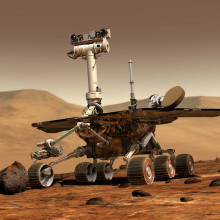
Hot springs eternal, on Mars
A broken wheel could have uncovered the best prospects yet for finding life on Mars, say scientists this week.
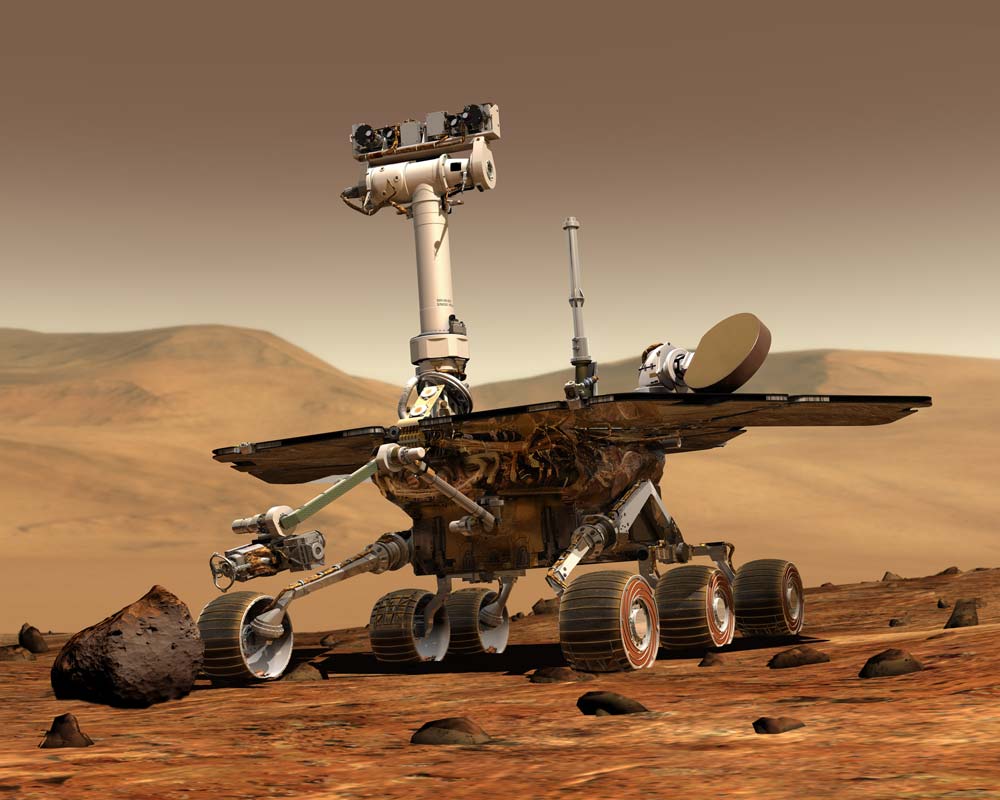 Writing in this week's Science, Cornell researcher Steven Squyers and his colleagues describe how the movement of their rover, Spirit, which has a broken wheel, carved a furrow into the Martian surface, revealing a layer of very white-coloured material. Intrigued, the team turned the rover's instruments on the light coloured layer and identified it as silicate, a mineral which forms around structures such as hydrothermal vents and fumaroles when hot mineral-laden water emerges, cools and drops its cargo of salts.
Writing in this week's Science, Cornell researcher Steven Squyers and his colleagues describe how the movement of their rover, Spirit, which has a broken wheel, carved a furrow into the Martian surface, revealing a layer of very white-coloured material. Intrigued, the team turned the rover's instruments on the light coloured layer and identified it as silicate, a mineral which forms around structures such as hydrothermal vents and fumaroles when hot mineral-laden water emerges, cools and drops its cargo of salts.
On Earth, environments like this contain abundant forms of life, and silica turns out to be extremely good at preserving them. So this discovery, say the researchers, is important for two key reasons. First it confirms that Mars had significant water in the past, but second it also pinpoints an important place to look for life in future.
"On Earth, hydrothermal deposits teem with life and the associated silica deposits typically contain fossil remains of microbes," says co-author Jack Farmer, from Arizona State University. "But we don't know if that's the case here because the rovers don't carry instruments that can detect microscopic life. What we can say is that this was once a habitable environment where liquid water and the energy needed for life were present."
The discovery was made as Spirit explored a football-field sized region called Home Plate which sits within a giant 100 mile wide crater. Together with its partner Opportunity, Spirit began to explore Mars in early 2004 on a mission designed to last just 3 months. Now, four years later and in spite of a battering by the Martian weather and accumulating dust on their solar panels, both rovers are still making discoveries. Even more ironic is the fact that had Spirit not had a broken front wheel, this particular finding would never have been made!

09:00 - Materials that heal themselves
Materials that heal themselves
with Ian Bond
Chris - Scientists at Bristol University, and this is a piece of research led by Dr Ian Bond, have come up with a material that can automatically put things right. Ian's with us to talk about it. Hello Ian, thank you for joining us. How does this actually work?
Ian - We've been developing, over a couple of years now, a composite material that can self-heal. We have small vessels inside the structure with a liquid inside them. Upon a damage event these rupture and bleed out liquid to effect some kind of healing within the structure.
 Chris - What are the chemicals you are using to do it?
Chris - What are the chemicals you are using to do it?
Ian - We've been concentrating primarily on using standard 2-part epoxy systems which are the mainstay of the aerospace industry. There's obvious improvements that can be made to those because they're pretty much off-the-shelf systems at the moment.
Chris - So the way it would work is you would have one chemical in one type of tube, one in another and where the damage is the two chemicals are blended together and they react?
Ian - That's exactly how it works so you do need both of them to be present. I guess one of the challenges at the moment is somehow making that reaction or mixture less sensitive to the particular mixed ratios, for instance, so that you can have quite a robust healing process that's not dependent on a certain amount of one or the other being there.
Chris - How much of this stuff do you need and what are the applications for this immediately here on the ground.
Ian - We're looking to address the very subtle damage in the structure. If there's a hole in the structure, for instance we like to think that somebody may notice that beforehand. It's the dings and bangs and wear and tear. It's the small cracks that begin in the structure which are difficult to detect which we're hoping to address.
Chris - So this would be aeroplanes, cars even?
Ian - It could be used in cars, yeah. I guess safety critical structures are what we're aiming at primarily. I guess in a car if it breaks you can generally pull over to the side of the road. In an aeroplane you don't have that option. Certainly in space you definitely don't have the option.
Chris - How much weight does this add? In the aerospace industry weight is everything. Does this make a plane weigh twice as much and therefore it's not going to be useful?
Ian - The idea here is although we may be adding some weight you can use lighter weight structures. At the present design is such that you allow for damage from day one. You have to have a heavier-weight structure than you would otherwise. You have to cope with the fact that you're fighting with one hand behind you back, as it were. You're assuming there's damage there. If you could somehow build in an ability to recover some of that damage by healing you could potentially have a lighter-weight structure overall.
 Chris - With the current missions to Mars on the agenda for the next 30 years or so and the fact that space rockets get hit by things like micrometeors quite often could this system work in space?
Chris - With the current missions to Mars on the agenda for the next 30 years or so and the fact that space rockets get hit by things like micrometeors quite often could this system work in space?
Ian - It could do. We've done some previous work looking at this. There's a lot of challenges. The temperature is an issue, the low vacuum. The extremely high velocity of the impact you mentioned from things like micrometeoroid. I guess it's the inner structure you might want to protect where they're perhaps not as exposed to the external environment. You want to maintain structural integrity on say a liner where you have a manned vehicle. I wouldn't necessarily advocate that we use this on an external structure that's going to be hit by a micrometeorite but it could be used in some form, perhaps in an inner structure within that.
Travel time to Mars?
That is probably quite pessimistic I think it takes less than 4.5 years to get to Mars, for example Phoenix only took 10 months to get there, and if you were carrying people you would probably travel faster. Probably somewhere around 6 months or so, depending exactly the orbits and the trajectories that you're looking at and how close Mars is to Earth at the time. The way it's normally done is that every two years Mars does a close swing past of Earth. That's when we launch all our space missions: every 2 years. What you're looking at for a human mission is you're either going to go there and back, quickly while Mars is close or you go there, stay for 2 years and then come back again.One of the worries with human health isn't just the microgravity and that making our bones thin. Radiation on Mars is going to be a serious problem because it doesn't have the atmosphere that the Earth does and it doesn't have the magnetic field that the Earth does to protect us. It's not just the space journey. It's also on Mars itself. we're going to have to think very carefully about how we shield our astronauts.
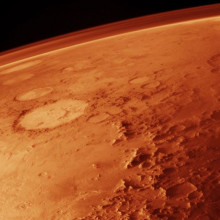
17:04 - What Shaped the Surface of Mars?
What Shaped the Surface of Mars?
with Susan Conway, the Open University
Chris - Susan Conway is from the Open University. She's studying the processes that have helped to shape the surface of Mars over the last four-and-a-half billion years. Hello Susan.
Susan - Hello there.
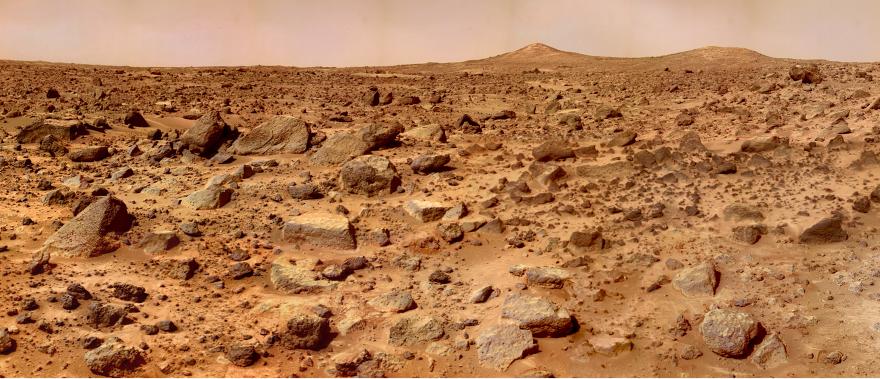 Chris - Thank you for joining us. What does Mars actually look like if you were to go and stand there? We have actually got pictures from it.
Chris - Thank you for joining us. What does Mars actually look like if you were to go and stand there? We have actually got pictures from it.
Susan - We have, that's right. Where the Mars Phoenix lander is going to land is up near the North pole. It's getting on for about late spring there so if someone was on the space ship and they touched down they'd obviously need a pretty good space suit because the atmosphere's quite thin. It would be pretty cold and what they'd see when they got there? Probably quite a bit of white frost. This is not water. This would be CO2, carbon dioxide, and they'd be looking about them . You might see black rock. You might see reddish sand as well, in amongst the bits of frost.
Chris - Why is it so red?
Susan - It's the iron content of the material so the dust is actually quite high in iron. As you know when you expose iron to the atmosphere it forms rust. That's the red colour. It's basically a rusty planet.
Chris - And the sky? We're used to the sky on Earth being a nice blue colour during the day. What do you see on Mars?
Susan - Well, it depends on the atmospheric conditions. On a really bad day: completely black. You wouldn't be able to see anything at all. You wouldn't be able to see you hand in front of your face.
Chris - Why not?
Susan - Well, the winds on Mars create these huge dust storms. They kick up all this dust and basically just like being in fog but instead of it being water it's all this really fine, red dust. You wouldn't be able to see your hand in front of your face.
Chris - Do we know what drives those dust storms, because you were saying the atmosphere is very thin. If you've got virtually no atmosphere, how do you get such strong winds?
Susan - Well, the temperatures on Mars have a huge difference. To compensate for the thin atmosphere you've got these huge temperature differences. We're talking -60 up to 25 degrees in different hemispheres in Mars. That drives these extremely strong winds that pick up this really fine dust making these huge dust storms.
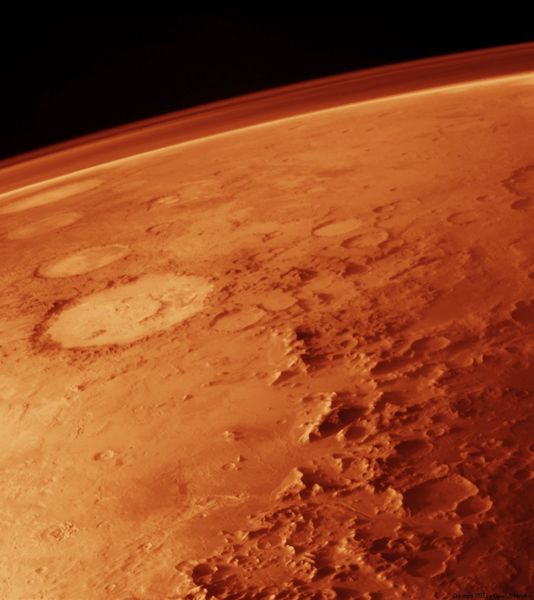 Chris - One of the interesting things when the 2003 Mars Express mission from the ESA (European Space Agency) got to the red planet it started to give us these amazing pictures of the surface of the planet. There are gullies, there are ridges. It's the most extraordinary sort of surface scape, isn't it?
Chris - One of the interesting things when the 2003 Mars Express mission from the ESA (European Space Agency) got to the red planet it started to give us these amazing pictures of the surface of the planet. There are gullies, there are ridges. It's the most extraordinary sort of surface scape, isn't it?
Susan - It is amazing, yes. Not only the Mars express but we've got the MRO, the Mars Reconnaissance Orbiter is sending back images of 25cm per pixel . You'll be able to see this studio, you'd be able to see a car on Mars, that sort of thing. This is bringing back amazing pictures of some weird landscapes that you just wouldn't expect. Big dunes, gullies that look like they've been formed by water. Just some really amazing stuff.
Chris - And it's also home to the biggest volcano in our solar system, isn't it? Olympus Mons.
Susan - Yes, that's right. Absolutely massive.
Chris - Those gullies that you mentioned look like they've been carved by water because if you compare them to what we have on Earth, say the Grand Canyon or something. Although they're on much bigger scale they do look very similar, don't they? Is it water?
Susan - That's up for debate. There are two features we're looking at. There's a huge feature that you can see that's a Grand Canyon Vallis Marineris kind of feature. The massive one you can see on Mars. That's thought to have been carved by water a really long time back in Mars' history so we're talking 2.5 billion years ago.
Chris - That is a long time ago. I thought some of these things looked a bit more recent than that.
Susan - That's right, these are smaller features. A couple of kilometres long and you can only see them in the most high resolution images. They're sinuous. They've got no craters on at all which shows that they're really recent. They look just like gullies that you would find in a ploughed field that's just got water washed over it or on the badlands. If you imagine a desert scenario and you've got the gullies formed in the badlands. It kinda looks like that.
Chris - If it's not water, what else could do that?
Susan - There's a couple of other theories. Scientists think that maybe it could be dry mass wasting. That's where material just breaks off and falls down the slope in response to gravity. People have difficulty with that because the morphology is not quite the same. The shape is not quite right. That could be due to the different sediment properties and gravity on Mars. It could be some kind of CO2. Maybe a CO2 avalanche that picks up material and takes it down slope; maybe a CO2 explosion so suddenly the CO2 gets heated up and then that explodes something like a volcano and picks up loads of stuff and tumbles down-hill because it's denser than the atmosphere.
Chris - Are you doing experiments here on Earth to model how that would occur so that you can then match up what you find in the laboratory with the pictures we've got to see which of these explanations it's most likely to be.
Susan - Yes, we're doing experiments in a Mars chamber that has the same atmospheric pressure and the same temperature and we're running water downhill there to test the water hypothesis. To see if water could actually be stable – because obviously it's outside the stability field for water – it's too cold, too little pressure for water; to see if water can stay active and mobile for long enough to form these features. We're testing that hypothesis.
Chris - What's your gut feeling at the moment?
Susan - I think it's water, personally. It's all up for debate, we'll have to see.
Chris - If it is water, looking at the terrain, when do you think water last ran?
Susan - It could be anything in the last 100,000 years.
Chris - Which is very recent, isn't it?
Susan - it is very recent, yes.
Chris - Which means, if there was life there it could still have been viable up until 100,000 years ago which is a blink of an eye isn't it?
Susan - Yeah. If the water formed these features and then has gone back into the ground and we still have liquid water beneath the ground little micros still could be living there in the rock, eating the rock, eating the water and still sitting there waiting for us to discover them.

How fast is Gravity?
There was a recent experiment to look at just this sort of thing, which looked at how light was bent by the gravity of Jupiter.
Our recent observations are yes, we think the gravity travels at exactly the same speed [as light].
If you plucked the Sun from out of its orbit - just removed it completely - we would still orbit around the sun for eight minutes before, suddenly, the Earth realised that it wasn't there anymore and disappeared off into space.
A wonderful statistic I heard from Brian Fulton, who was professor of Astrophysics at York, is that the light emerging from the Sun (because the sun's so big and massive and has so much gravity) the light is already something like a million years old. Even if the sun went out tomorrow we'd still have a million years' more light...
Would a compass work on Mars?
No, it would not. Unfortunately Mars does not have a magnetic field anymore. The magnetic field on Earth is generated by the core rotating inside the Earth and Mars has just cooled down too much and that whole process has just been frozen. So it has lost its magnetic field. Some rocks are still magnetised but the planet itself has no overall field.
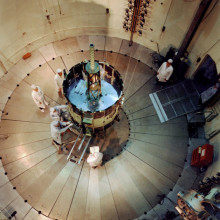
24:47 - Making a Mini Mars for Testing Probes
Making a Mini Mars for Testing Probes
with Martin Towner
Meera - This week I've come down to the labs of the Planetary and Space Sciences Research Institute at the Open University in Milton Keynes. It's not your average kind of lab as there isn't a white bench or a white coat in sight. There are large metal vessels all over the room with circular windows basically looking like mini space ships all over the place. I'm here with Martin Towner who's a research fellow here at the Open University. He's going to tell me what these vessels are really here for.
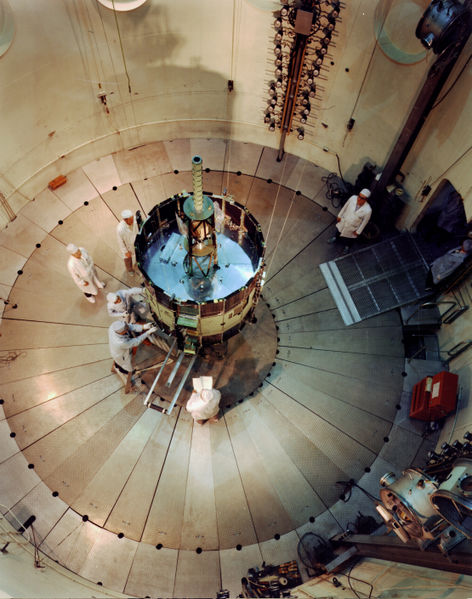 Martin - These chambers all get used to simulate conditions on other planets in the solar system. This particular area is mainly to do with the testing and building of instruments. We have a whole bunch of different areas to simulate the environments that space craft have to go through on their way to get to Mars or to get to Titan and to land and survive for a period of time. The majority of our work is simulating the Mars conditions for upcoming future missions.
Martin - These chambers all get used to simulate conditions on other planets in the solar system. This particular area is mainly to do with the testing and building of instruments. We have a whole bunch of different areas to simulate the environments that space craft have to go through on their way to get to Mars or to get to Titan and to land and survive for a period of time. The majority of our work is simulating the Mars conditions for upcoming future missions.
Meera - What is the environment like on Mars?
Martin - Mars is very different from the Earth. The atmosphere is a lot thinner than Earth's and is also CO2, carbon dioxide rather than oxygen and nitrogen like we have here. It's also a lot colder and a nice sunny day on the equator on Mars might get up to just above freezing. Whereas a cold winter night time you might be talking -120C. The sunlight is also very different. Mars is farther from the Earth so the light is a bit dimmer but it's also a lot harsher because there's no ozone layer around Mars. You have strong UV, ultra violet on the surface. On Earth the burn time of our day is half an hour where as on Mars you're talking a couple of minutes.
Meera - That's a big difference.
Martin - It would probably be the least of your worries if you were on the surface. The ultraviolet is so strong that it effectively sterilises the surface of the planet.
Meera - How do you know that these are definitely the conditions?
Martin - In most of the cases they've actually been measured. There have been space craft that have landed on Mars, they've measured the temperature, the wind speed, the air pressure. We actually have data for that. There are big climate models in the same way that people do climate modelling on the Earth. People do climate models for Mars as well so the global conditions are understood. Things like the ultraviolet fluxes are well known but can be modelled because you know the composition of the atmosphere. You know how far away from the sun you are so you can work out all these things.
Meera - We've got out all these chambers here in which you tried to recreate these conditions. How'd you go about doing that?
Martin - Because of the low pressure on Mars you have to have a big metal chamber that you can take the air out of and then fill it with a Mars atmosphere. You have a big pump connected to a big metal chamber and this one is about 2m long and about 1m diameter. Pump all the air out. Fill it with a bit of carbon dioxide, which gives us the atmosphere. We have a bunch of big lamps which can be switched on and off by computer to give us the day-night cycle. The Mars day is slightly longer than the Earth day.
Meera - What kind of lamps?
Martin - Ultraviolet lamps and then also a normal light bulb type lamp that gives us the visible spectrum as well as the ultraviolet. We need both. Temperature is done using liquid nitrogen through a big copper plate. Liquid nitrogen will get us down to below -150 which covers the worst case on Mars. Then we can control that to bring it up and down to do the day-night cycle or to simulate different areas of Mars: equator, North Pole, South Pole. Things like that.
Meera - Do you put all of these conditions in each chamber in one go or do you look at different things in each chamber?
Martin - No, the chambers tend to be specialised for people studying astrobiology like life on Mars. They want a small, nice clean chamber. They may not be interested in the light. They might just want it cold and dark because they're studying things that are underground. Whereas if someone is doing more physical processes like wind and sand blowing around they may want a great big chamber so that the air has got space to move. They might not be too interested in getting the absolute coldest temperatures because things like wind-blown sand is not really dependent on whether it's -20 or -50.
Meera - Why is it important? What kind of effects do these conditions have on the instruments in the first place for you to have to study this so much?
Martin - Mainly it's the temperature, especially when it gets very cold at night and then a little bit warmer during the day. You repeat this day after day after day and it just starts to have wear and tear on the instrument: on the joint, on the soldering and the electronic components in the instruments and also things like the battery as well. You also have to be very careful with the lighting. Things like plastics tend to degrade under strong ultraviolet conditions.
Meera - How do you overcome this?
Martin - It's the old adage of test, test and test again. You have to pick the right materials so that they don't crack or fade or bend or just creep slowly under these conditions. This also effects the accuracy of the instrument as well which you have to measure so that somebody knows their instrument works equally well at -60 as it does at -20 in the middle of the day or the middle of the night. You just have to work your way through all the different combinations of instruments and environment conditions and then weed out anything that doesn't make the grade and replace it with maybe a better material or a better design.
Meera - Survival of the fittest?
Martin - Yes, basically.
Meera - Is there nowhere on Earth you could go to try and get these conditions naturally?
Martin - There are some places that are close. The Antarctic dry valleys are the ones that people traditionally use. It's very cold, very dry. Because of the conditions you get a strong ultraviolet from the sun but you don't get the right atmosphere. You're still trapped in the Earth's atmosphere and at a practical level doing fieldwork to Antarctica and taking all your instruments out there is actually a lot more expensive than building a chamber in the lab and testing here.
UV and Solar Panels?
Yes there is a lot more UV on the surface of Mars because we don't have the atmosphere to protect us. However, Mars is a lot farther from the sun than the Earth is. The sunlight in general is a lot dimmer and solar panels don't just respond to UV. They respond to normal light as well. There's also a lot of dust in the atmosphere of Mars which is a major problem with the solar panels on the recent rovers. They get covered in dust and stop working effectively.
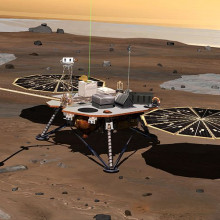
32:52 - The Phoenix Mission
The Phoenix Mission
with William Boynton, University of Arizona,
Chris - The Phoenix is literally hours away from touching down. You must be pretty nervous?
William - I am. It's been a long wait and there's not too much we can do about it now but we're just going to watch and hope everything works well.
Chris - Just tell us a bit about Phoenix. What is it first of all?
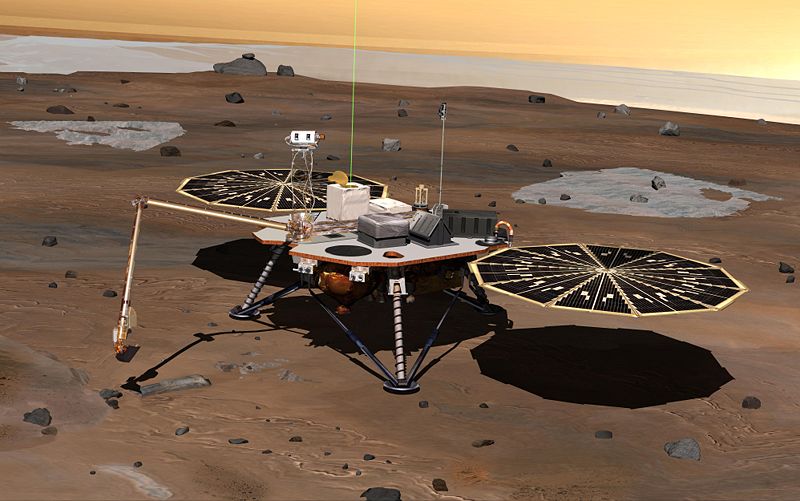 William - Phoenix is a lander. It's unlike the rovers that are currently scooting about Mars. This does not have wheels. We're going to land in one location near the North Pole of Mars. Wherever we land that's where we stay. It does have a robotic arm that can reach out a little bit less than 2m in any direction and dig up some dirt and deliver it to my instruments: a thermal evolved gas analyser and another instrument that has a microscope and wet chemistry lab and be analysing the soils that it digs up.
William - Phoenix is a lander. It's unlike the rovers that are currently scooting about Mars. This does not have wheels. We're going to land in one location near the North Pole of Mars. Wherever we land that's where we stay. It does have a robotic arm that can reach out a little bit less than 2m in any direction and dig up some dirt and deliver it to my instruments: a thermal evolved gas analyser and another instrument that has a microscope and wet chemistry lab and be analysing the soils that it digs up.
Chris - What key questions are you looking to answer?
William - I guess the big key question is to understand the environment and see if it could have been either now, or more likely in the past, hospitable for life. The mission is not really a life detection mission such as Viking was a long while ago. This mission is more to understand the conditions and just see if Mars might have been hospitable for life.
Chris - Why have you picked the North Pole?
William - We're there in large part because we've found there's ice just beneath the surface. This was a discovery made with another instrument I've been involved with: a gamma ray spectrometer on the Mars Odyssey Mission. We found that the whole North Polar region, northward of about 60 degrees latitude, has very large amounts of ice just buried a centimetre or two beneath the surface. What we're thinking is that ice might provide a special environment to preserve conditions. Perhaps organic molecules might have survived.
Chris - What sort of ice is that? Is that water ice?
 William - Yes. This, what we're speaking of is water ice. As I think one of your earlier guests mentioned when we land we might see a bit of CO2 frost on the surface. During the winter time on Mars it gets cold enough that the atmosphere, which is almost pure CO2, will condense out on the surface and we can have in the order of 1m thick layer of CO2 frost covering the ground. The ice I'm talking about here is regular water ice that would be beneath the surface. There's a lot of it: as best we can tell somewhere in the order of 70-85% ice and maybe only 20% dirt.
William - Yes. This, what we're speaking of is water ice. As I think one of your earlier guests mentioned when we land we might see a bit of CO2 frost on the surface. During the winter time on Mars it gets cold enough that the atmosphere, which is almost pure CO2, will condense out on the surface and we can have in the order of 1m thick layer of CO2 frost covering the ground. The ice I'm talking about here is regular water ice that would be beneath the surface. There's a lot of it: as best we can tell somewhere in the order of 70-85% ice and maybe only 20% dirt.
Chris - What season is it at the moment on Mars?
William - Right now it's springtime. The ground is warming up. The CO2 frost is leaving, It's possible when we get there all the CO2 frost will be gone. We might still see some in the shadow regions behind rocks. It is warming up.
Chris - When you say warming up, you mean relatively speaking? That's still pretty cold, isn't it?
William - It's still pretty cold. We expect the temperatures will be about -40 or something like that. Perhaps the middle of the day getting warmer.
Chris - How long will the mission last? How long will Phoenix be able to tolerate those conditions to do the experiments?
William - We expect the hardware itself to survive about six months. So far the mission is only scheduled to go for three months and if everything is going well we're hopeful that NASA will come up with some extra money that we can go for another three months. The craft is solar powered and since we're near the North Pole once the winter starts we lose the sunshine so there's no longer any power for the lander itself.
Chris - What's actually going to happen today and what are the steps as Phoenix comes in to land on Mars?
William - It's actually pretty involved process but what happens is it enters the top of the atmosphere. It has a heat shield very much like the one the Apollo capsule or the same idea as what the space shuttle had when it re-entered. It can withstand high temperatures and is essentially something that can get very hot and use friction to slow the space craft down, a large fraction of the speed. Then what happens is they get rid of that heat shield and they deploy a parachute which slows it down still more. Because Mars' atmosphere is very thin as one of your earlier guests pointed out the parachute doesn't do too well in terms of slowing us down but it will still slow us down. The final bit we do with retrorockets. It's kind of an old fashioned way of doing it compared to what was done more recently with air bags surrounds.
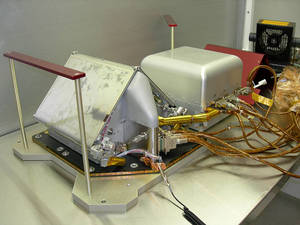 Chris - That was Beagle 2 and it didn't go so well. We don't know what happened to Beagle 2.
Chris - That was Beagle 2 and it didn't go so well. We don't know what happened to Beagle 2.
William - That's true, we don't. It was also the same technology used on the moon rovers though which did survive and Pathfinder as well. The problem is when the landers get to be very big the airbags get to be very big and it get'smore difficult to we're going back to the technology that we used on the Viking mission and we're very hopeful that this will set us down very gently.
Chris - Thank you very much for joining us, William. I hope that you'll be able to join us in a few months' time when it's all gone well, fingers crossed. And you'll have some data for us.
William - I'd be very happy to do that.
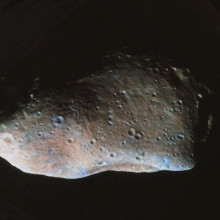
39:09 - The Meteorite that Killed the Dinosaurs
The Meteorite that Killed the Dinosaurs
with Bill Bottke
Phil - According to our next guest, Bill Bottke from the Southwest Research Institute in Colorado that's exactly what happened to bring about the demise of our dinosaurs.
Chris - Hello, Bill. Where did this asteroid come from in the first place?
Bill - One of the interesting mysteries that we've had in the field of asteroid impacts and such is what kind of body produced the impact that killed the dinosaurs about 65 million years ago. In the process of doing a completely unrelated project we came across evidence for a very large asteroid breakup that happened in the asteroid belt between the orbits of Mars and Jupiter. This break-up event was about a 170km asteroid. We believe using different techniques we could tell its age, that it broke up 160 million years ago. Interestingly enough the fragments from this break-up event took a long time to get out of the asteroid belt into the inner solar system. We think there's a pretty strong chance that one of these fragments was actually the killer bullet that brought about the end of the dinosaurs 65 million years ago.
Chris - What were those asteroids doing there, next to Mars anyway?
Bill - The asteroid belt itself we believe is the leftover remnants of the original building blocks which formed the planet. At one point when the planets were forming in the solar system we had a lot of objects that looked like asteroids. We had bigger objects that ultimately became moon-size and ultimately we built the planets like Mercury and Venus and the Earth. There were some leftovers and these leftovers were caught in the somewhat stable region between Mars and Jupiter. The Asteroid belts in a sense are our ancestors. They tell what the original building blocks looked like.
Chris - How did they jostle together in such a way that one of them ended up on a collision course with Earth so recently? 68 million years ago in a solar system that's over 4.5 billion years old is really recent.
Bill - It indeed is. Something some of your listeners probably don't know but it's interesting to think about is, why do we even have asteroids hitting the Earth? Why should this take place? If you place asteroids on orbits close to the Earth and such eventually the Earth will clear them away and there'll be nothing left. It turns out that the asteroid belt has mechanisms take place. It's inside it which actually in certain interesting ways can cause small asteroids to move out of the asteroid belt and out on to orbits where they can cross the Earth's path. This has to do from a combination of effects. There's actually a player in this game how sunlight effects asteroids. Another player in this game is how the tiny gravitational kicks produced by Jupiter and Mars can actually move asteroids from the asteroid belt into the inner solar system.
Chris - The big question is, are there any more loitering out there that could do for us?
Bill - Certainly. Right now there's probably on the order of about 1000 asteroids larger than 1km in diameter that can either cross Earth's orbit or they can come very close to the Earth. Fortunately we've had astronomers from around the world searching for these asteroids and we've actually found, we believe, a good fraction of all the big ones. We've probably found around 70-80% of these kilometre size asteroids. None of them, fortunately, in a trajectory that will take them into the Earth. There are some others out there that we're still looking for and there's some smaller guys that perhaps won't cause global damage but could cause regional damage. We're going to continue to look for the next several tens of years until we find all the threatening asteroids.
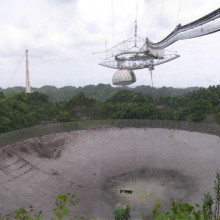
43:15 - Communication With Nearby Stars?
Communication With Nearby Stars?
Because light travels at a fixed speed it takes a long time for a signal to reach us. The basic problem with communicating with aliens is that the nearest stars are 3-10 light years away. If you said hello it would take three years for that message to get to the alien star and three years to come back. The other problem of course is aliens will not necessarily have communication of the same kind as us. What we would have to do is send signals that are numbers like 2, 4, 6, 8. That's the content of the communication. The second part is how do we communicate? Scientifically I think there are two really approaches that are currently available to us on Earth. One is the standard technique which is to use radio signals and we listen with the biggest telescopes on the Earth. The Arecebo telescope, which is a 300m diameter has been used. Radio astronomers are currently working on the design of a radio telescope which will be ten times larger. Those telescopes will be mainly used to listen for extra terrestrial life. An alternative approach is to use lasers. Lasers have the advantage that they're highly directional. You could point high-powered laser at a specific star. One thing about technology is that we're in a period where technology's improving all the time. If you want to communicate with aliens and you think it's going to take many years to start this conversation it is possibly better to wait maybe 10, 20, 30 years until our technology improves significantly.
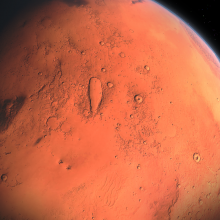
How long are the seasons on Mars?
Seasons happen here on Earth because the planet is tilted on its axis by about 23.5º. This means that, during part of its journey around the Sun, the Earth's northern hemisphere receives more solar energy than the southern hemisphere; during the other half of the year, the reverse is true. This difference in solar input is what leads to the changes in average temperature in those hemispheres that we refer to as "seasons".
Compared with the other rocky planets, the seasons on Mars are the most similar to those of Earth. This is because, like Earth, Mars is also tilted on its axis and by a very similar amount: 25º to the vertical. This produces temperature changes that alter like those on Earth across the year as Mars orbits the Sun.
But a year on Mars - lasting 687 Earth days - is considerably longer than an Earth year (365 days) because Mars orbits about 50% farther again from the Sun than Earth, so it has a greater distance to travel. The shape of Mars' orbit is also a bit more elliptical than the Earth, so the seasons are not all the same length. "Spring" on Mars lasts 7 months; "Summer" goes on for 6 months; "Autumn" lasts a touch over 5 months, and "Winter" is 4 months long.
The "Summer" temperatures on Mars are definitely nothing to write home about though and compared with Earth, where 50ºC is encountered in some places, the top temperature on Mars is usually barely above zero... Some "Summer" huh?
What can we learn from asteroids?
The asteroid belt is remains of a planet that didn't quite make it. So, we can look at those asteroids if we could get a sample of one we could look at its structure and then basically we can explore what would be in the Earth's centre so the core and the mantle and their composition by looking at these asteroids. They're a kind of vestige of what we're made of and one of the bonuses is sometimes we get meteorites fall on the Earth which is essentially bits of asteroid. We can analyse those in our labs. We've got bits of Mars here on Earth just a few little bits that have come off and been blasted by asteroid impacts and just through luck have landed here and someone's found them.
Why should Martians be carbon based?
Essentially we assume that because that's all we know. People have speculated that there could be silicon-based life or other, more exotic forms of life but we've only ever seen carbon-based life. It's a good place to start, really. Something that's based on carbon and water is probably what we're looking for. If we look for something more exotic we'd probably struggle to find it in the first place.
How long would it take to terraform Mars?
It's likely to take hundreds of years, as you've got to change the composition of the atmosphere of a whole planet. You need got to undo the reasons that Mars doesn't have an atmosphere already, which is that it doesn't have a magnetic field. The solar wind has gone past, but there's no magnetic field to deflect it, so much of the atmosphere has been lost. We're still looking at probably 30-50 years before we send a man to Mars, which we will almost certainly need do do before we even think about starting to terraform Mars.
Are there dinosaur bones in Britain?
The answer is certainly yes. You can see quite a lot of examples if you go to the Natural History Museum or if you're local, go to the Sidgwick Museum in Cambridge. One of the researchers there is digging up Plesiosaurs, a swimming reptile closely related to dinosaurs locally in Ely.
Are there completely unknown elements on Mars?
Basically. The same laws of physics apply here as apply on Mars, well we think as least, as everywhere else in the Universe. It would be the same basic elements: carbon, silicon. The same elements but we do get some different mineralogy. The way they are fitting together on Mars is often slightly different to the way it works on Earth.
Is there a magnetic equivalent of a black hole?
According to Einstein gravity attracts things, because it bends space, and a black hole occurs when this bending becomes extreme. As far as we know electric and magnetic fields don't bend space in the same way, so they wouldn't create a black hole. Also because like charges repel it would be very difficult to squeeze a large amount of charge together, so even if theoretically you could produce an electric or magnetic black hole practically it would be impossible.
But, in theory a black hole can be magnetic or at least the gas that's swirling around it would be magnetic. The gas becomes charged and essentially becomes electric current going around the black hole along with all the matter. You get a magnetic field created there. Whether you get something that actually sucks in magnetic field may be slightly different. Magnetic field in theory is related to light so really black holes should suck it all in at the same time.
- Previous How Would ET Phone Home?
- Next Talking Monkeys and Forming Fossils
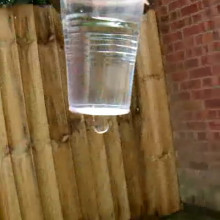










Comments
Add a comment